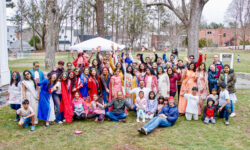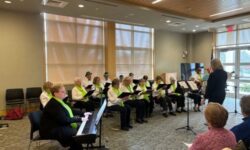by Audrey Anderson
Hometown Weekly Reporter
Judith Kalaora, a professional educator, researcher, writer, and living historian, is the founder and artistic director of History at PlayTM, a company that presents living history programs worldwide. The company’s programs focus on “influential and often forgotten women” in history, such as Hedy Lamarr, Lucy Stone, and Deborah Sampson. The Friends of the Walpole Public Library and the Walpole Council on Aging brought History at Play’s program about Princess Diana, Diana of LOVE, to 60 South Street in Walpole on Thursday, June 1.
Diana of LOVE is a one-woman show researched, written, and performed by Kalaora. It dramatizes Princess Diana’s own feelings about her marriage to Prince Charles, her loneliness in becoming a popular working royal at the age of 20, her bulimia, the births of William and Harry, her divorce from Prince Charles, and her evolution into a strong advocate of loving and helping the unfortunate and working to correct wrongs in the world, such as the danger of active land mines in Angola.
The piece starts as Diana has just finished her emotional and revealing Panorama interview, and she is back in her apartment at Kensington Palace, thinking it over. She remembers how lonely and frightening it was to become engaged to Charles, her first boyfriend, at 19 years old. Though she was in the royal circle, she was not used to palace protocol, the paparazzi, and Charles’ unkind comments about her weight, his jealousy of her popularity, and his attention to Camilla. Her life was spiraling, and the only thing in her control seemed to be how much she ate and then eliminated.
As Kalaora touched on Diana’s low and high points, she used music, dancing, spare props, and several costume changes to bring an evolving Diana to life. Mannequins represented Diana’s mentor Princess Grace and her close friend and AIDS patient Adrian Ward-Jackson. Kalaora unveiled a large photo on an easel depicting Diana dancing with John Travolta, as she discussed how she wanted to be remembered.
Kalaora’s deft accent, mannerisms, laughter, and soft speech matched Diana’s. She communicated Diana’s feelings of being hurt or feeling happy through her nuanced facial expressions and gestures.
The audience was quickly enthralled by the intimacy of the performance. Kalaora interacted with the audience, asking questions and then waiting for answers, and walking through the middle aisle greeting people in character. The pace of the monologue and storyline kept the audience glued to the action.
As Diana moved away from Charles, her character became stronger and more devoted to people and her causes. The revenge dress made an appearance. Diana talked about AIDS and how meaningful it was to shake patients’ hands without wearing gloves and to hug them. She also used the press to highlight the danger from land mines in Angola, having photographers cover her as she walked through the country wearing a protective vest.
On stage, a mannequin wearing a protective vest symbolized Diana, and it was shrouded to end the program.


























